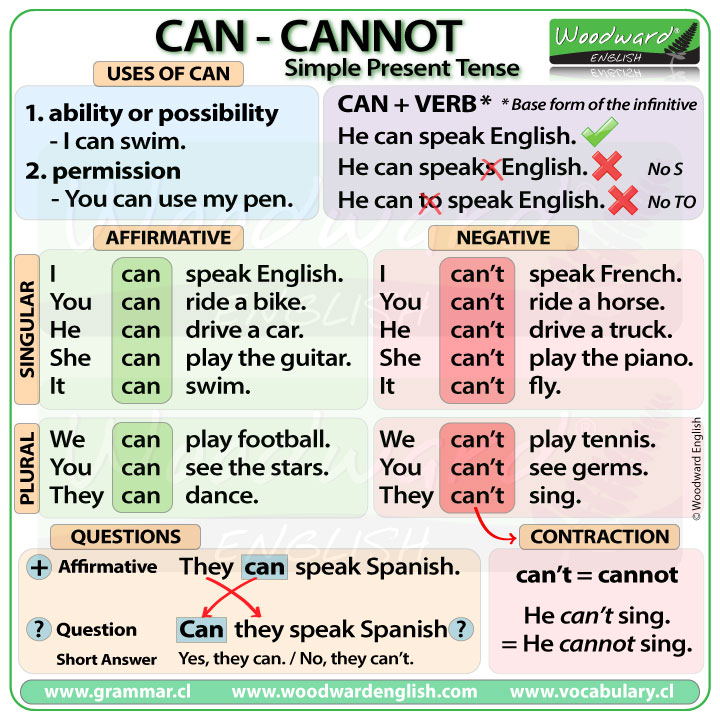El verbo can
La forma más simple para decir que sabemos hacer algo es con el verbo modal can. Decimos: I can dance, literalmente, puedo bailar; I can speak Spanish, literalmente Puedo hablar español, etc.LA TEORÍA
La estructura es siempre la misma, incluso con he, she y it: sujeto + can + infinitivo sin to. Veamos algunos ejemplos:- Sé leer. I can read.
- (Ella) sabe tocar el piano. She can play the piano.
- No sé conducir. I can’t drive.
- (Él) No sabe cantar. He can’t sing.
- ¿Sabes jugar al baloncesto? Can you play basketball?
- ¿Sabe (ella) motivar a la gente? Can she motivate people?
LA PRÁCTICA
Los tres primeros ejemplos empiezan con el sonido /áikan/:|
Sé tocar el violín. |
I can play the violin. |
|
Sé escribir. |
I can write. |
|
Sé escribir en el ordenador o en el móvil. |
I can type. |
Hablando en negativa, ponemos el énfasis en can’t, /aikánt/:
|
No sé tocar la trompeta. |
I can’t play the trumpet. |
|
No sé jugar al poker. |
I can’t play poker. |
|
No sé cocinar. |
I can’t cook. |
A continuación tienes el sonido /kániu/:
|
¿Sabes jugar al fútbol? |
Can you play football? |
|
¿Sabes volar? |
Can you fly? |
|
¿Sabes hablar inglés? |
Can you speak English? |
EXTRA
Clave de pronunciación
Can se pronuncia simplemente así: /kan/. Incluso a veces no se oye la a. Pero hay que poner especial atención al decir can’t: /kant/, y marcar mucho la t.Error común
Nunca, jamás, digas el infinitivo con to después de can. No digas cosas como I can to say. ¡Fatal! Lo correcto siempre será I can say.¡Practica tú!
Para practicar can y can’t forma una lista de parejas de cosas que sabes y no sabes hacer, como: I can dance, but I can’t sing. Después convierte los ejemplos de tu lista en preguntas: Can you dance?Can is a modal verb.
Can is used to express ability or to say that something is possible.
Can is the same for all subjects.
We don't add an 'S' in the third person (like other verbs)
The verb that comes after Can is in the infinitive without to:
- I can speak Spanish. (= it is possible for me to speak Spanish = I have the ability to speak Spanish)
- He can swim well.
- We can see our neighbour in the garden.
- They can play the guitar.
Negative
To form the negative we add "not" after can to form one word: cannot.
We can also contract the negative to form can't. (can't = cannot)
- I cannot play the piano. We can't go to the cinema tonight.
- She cannot speak French very well. He can't drive a car.
Questions
To from the question we change the position of the subject and the auxiliary verb.
The main verb is still in the infinitive without to.
- Where can I buy an ice-cream?
- Can I go to the party, please?
- Can you speak Japanese?
- What can we do on Saturday?
Remember that you can use short answers:
- Can I sit here please? Yes, you can.
- Can you speak Chinese? No, I can't.

Ejercicio. Copia en tu libreta y completa las oraciones. (afirmativa o negativa)
- I ______________ swim. (+/can)
- You ___________ draw. (-/can)
- He _____________ cook. (+/can)
- She ____________ walk. (-/can)
- It ______________ jump. (+/can)
- We ____________ ski. (-/can)
- You ____________ read. (+/can)
- They ___________ count. (-/can)
- Doris ___________ sail. (+/can)
- Walter and Laura __________ sing. (-/can)
Descarga e imprime los siguientes archivos para responder y llevar a clase.
Grammar Practice
Grammar Games
No hay comentarios.:
Publicar un comentario